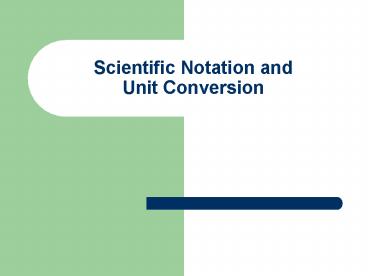Scientific Notation and Unit Conversion
1 / 18
Title:
Scientific Notation and Unit Conversion
Description:
Section 1. Measuring the very BIG and the very small. Distance between stars: ... Section 1. Converting Units. Build a conversion factor from the previous table. ... –
Number of Views:51
Avg rating:3.0/5.0
Title: Scientific Notation and Unit Conversion
1
Scientific Notation and Unit Conversion
2
(No Transcript)
3
Measuring the very BIG and the very small
- Distance between stars
- 100,000,000,000,000,000 m
- Distance between atoms in a solid
- 0.000,000,001 m
- Scientific Notation (much easier)
- 1 x 1017 m
- 1 x 10-9 m
4
Scientific Notation Worksheet
- Each person fills out their own
- Can ask for help but no copying!
5
Prefixes
6
Converting Units
- Build a conversion factor from the previous
table. Set it up so that units cancel properly. - Example - Convert 2.5 kg into g.
- Build the conversion factor
- This conversion factor is equivalent to 1.
- 103 g is equal to 1 kg
- Multiply by the conversion factor. The units of
kg cancel and the answer is 2500 g. - Try converting
- .025 g into mg
- .22 km into cm
7
Classroom Practice Problem
- If a woman has a mass of 60,000,000 mg, what is
her mass in grams and in kilograms? - Answer 60 000 g or 60 kg
8
Accuracy and Precision
- Precision is the degree of exactness for a
measurement. - It is a property of the instrument used.
- The length of the pencil can be estimated to
tenths of centimeters. - Accuracy is how close the measurement is to the
correct value.
9
Errors in Measurement
- Instrument error
- Instrument error is caused by using measurement
instruments that are flawed in some way. - Instruments generally have stated accuracies such
as accurate to within 1. - Method error
- Method error is caused by poor techniques (see
picture below).
10
Measurement of Parallax
Visual Concept
11
What do you think?
- What different ways can you organize data so that
it can be analyzed for the purpose of making
testable predictions?
12
Tables
- This table organizes data for two falling balls
(golf and tennis) that were dropped in a vacuum. - Can you see patterns in the data?
13
Graphs
- Data from the previous table is graphed.
- A smooth curve connects the data points.
- This allows predictions for points between data
points such as t 0.220 s. - The graph could also be extended.
- This allows predictions for points beyond 0.400 s.
14
Shapes of Graphs and Mathematical Relationships
Visual Concept
15
Equations
- Show relationships between variables
- Directly proportional
- Inversely proportional
- Inverse, square relationships
- Describe the model in mathematical terms
- The equation for the previous graph can be shown
as ?y (4.9)?t2. - Allow you to solve for unknown quantities
16
Dimensional Analysis
- Dimensions can be treated as algebraic
quantities. - They must be the same on each side of the
equality. - Using the equation ?y (4.9)?t2 , what
dimensions must the 4.9 have in order to be
consistent? - Answer length/time2 (because y is a length and
t is a time) - In SI units, it would be 4.9 m/s2 .
- Always use and check units for consistency.
17
Order of magnitude
- Rounds to the nearest power of 10
- The number 65 has an order of magnitude of 102
because it is closer to 102 than to 101 - What is the order of magnitude for 4200, 0.052
and - 6.2 x 1023?
- Answers 103, 10-1 , and 1024
- Allows you to get approximate answers for
calculations
18
Now what do you think?
- What different ways can you organize data so that
it can be analyzed for the purpose of making
testable predictions?































